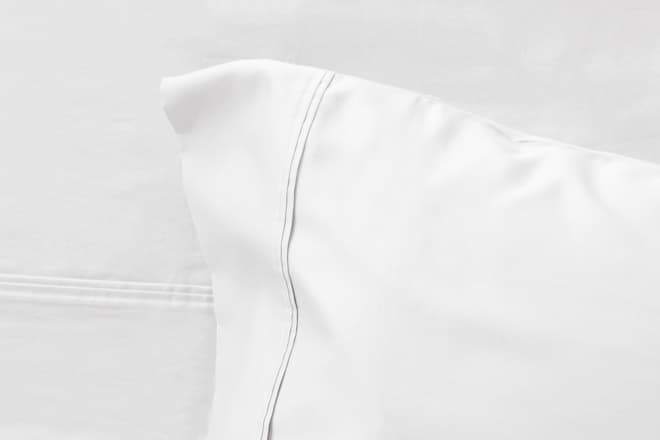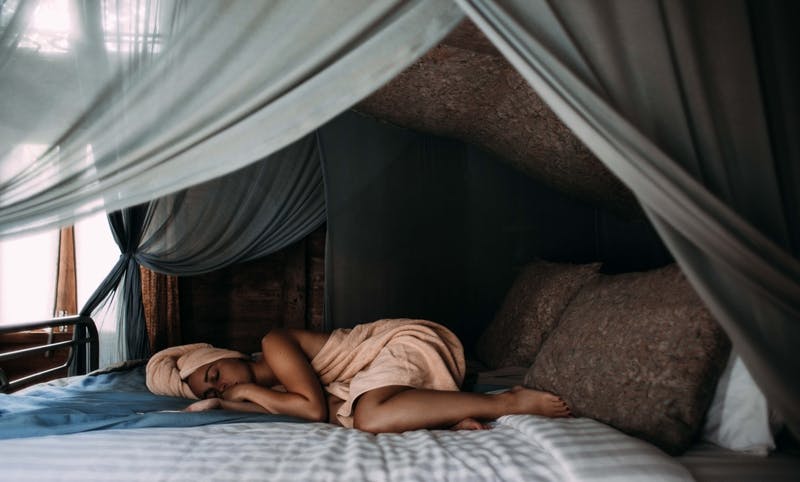Is sleeping without a pillow good for you? Or is it harmful?
Even when you get a good night’s sleep (which should be at least seven hours of solid ZZZ's), do you still find yourself waking up with stiff muscles or an ache in your neck or back?
Maybe you recently bought a new mattress—or are thinking of doing so—because you heard that the right mattress can help you get the best sleep.
That’s true, but it’s not just about the mattress. The quality of your pillow, or whether you sleep with one at all, can also impact your sleep quality.
Sleeping in Neutral
Chiropractors and sleep experts agree finding a neutral position to sleep in is key. By neutral, they mean a position that maintains better spinal alignment while you sleep, without tilting or curving.
So, whether or not you sleep with a pillow should depend largely on the position you sleep in most of the night. The right pillow can complement that position by keeping your neck and spine in line while you snooze.
The problem is, who actually stays in the same position all night? Most people dream and naturally toss and turn while sleeping. That means it's virtually impossible to maintain a neutral sleeping position throughout the entire night. Because most of us change positions several times throughout the night, we need support from our pillow in specific places to help keep our spines aligned while we sleep—regardless of the position we’re sleeping in.
The key places that need support from a pillow can differ depending on your go-to sleeping position. Here’s what’s recommended based on your favorite sleeping position.
Sleeping without a pillow: side sleepers
Did you know that sleeping on your side (especially your left side) is largely seen as the healthiest sleeping position of all by doctors? Sleeping on your side can be good for digestion and minimizing acid reflux. It’s also the position where you get the maximum amount of airflow, which is why it's also the recommended sleeping position for pregnant women.

Receiving maximum airflow also means that sleeping on your side can reduce snoring.
Sleeping on your side without a pillow creates a gap between your neck and shoulders, which can cause the spine to curve. Over time, this will likely cause pain and strain on your neck and lower back. So, side sleepers need a thicker, more supportive pillow that fills that gap and lifts the head just enough to keep it in line with the spine. Be careful not to get a pillow that’s too thick, though. A thick pillow will tilt the head up and create an unnatural curve.
The bottom line
Side sleepers shouldn't sleep without a pillow in order to keep their necks properly in alignment with the rest of their spine.
Pro tip
Some chiropractors suggest that placing a thin pillow between the legs can be a good idea for side sleepers. This provides even more support to the hips and spine. (The removable insert in the Leesa Hybrid pillow makes the perfect between-the-legs pillow!)
Sleeping without a pillow: back sleepers
Try this: lay flat on your back on the floor. Do you notice the gap between the back of your head and your shoulders? Now, try and get your neck to lie flat on the ground. See? You can’t do that without lifting your head (if you can even do it at all). Our heads are one of the heaviest parts of our bodies. When we sleep, our narrow necks and spines have a hard time supporting that weight.
The bottom line
If you sleep on your back, doctors and sleep experts recommend you always sleep with a pillow. For back sleepers, most doctors and chiropractors recommend a thinner, contouring pillow that will help fill the gap beneath the back of your neck and the bed while also supporting the weight of your head.
The right pillow will keep everything in line with your spine, from your head to your feet. A thin pillow, rather than a thick one, will do the job while preventing your head and neck from tilting up too much, disrupting the line of your spine. Occasionally, some sleep experts suggest replacing a pillow with a rolled towel. Try that and see if it works for you.
Pro tip
Some chiropractors also recommend placing a thin pillow under your knees to help relieve some pressure from your hips and encourage your spine to curve naturally. Again, the removable insert in the Leesa Hybrid pillow makes the perfect under-knee support.
Sleeping without a pillow: stomach sleepers
Many people find they’re most comfortable sleeping on their stomachs, especially with a deep, fluffy pillow to bury their faces in.
However, most doctors and chiropractors say sleeping on the stomach is one of the most unhealthy positions because it forces you to turn your neck to the left or right. Having your head turned all night can strain the neck throughout the night. Naturally, it takes your spine out of alignment, whether you use a pillow or not.
The bottom line
Sleeping on your stomach is the only position where experts say you can get away with not using a pillow. If you’re a stomach sleeper, try no pillow. Then, try a thin pillow for a few nights to see which way you get the best rest.
Pro tip
Since the side of one’s face is relatively flat, sleeping on the stomach with the head turned to the left or right helps keep the spine more closely in line with the mattress. So, if you sleep on your stomach, it's recommended to either sleep without a pillow or use a very thin pillow. A thin pillow beneath the hip area can also help keep the spine aligned while you sleep, keeping your hips from sinking into the mattress.
Some pros of sleeping without a pillow
If you experience neck pain and sleep on your back or stomach, you may notice improved sleep quality by sleeping without a pillow.
- One of the reasons this can improve your sleep quality is that a thick pillow can put stress on your neck and create an awkward angle for your sleep posture. It can also impact getting quality sleep.
- Research also suggests sleeping without a pillow while lying on your back can have a big impact on how you
- Sleeping without a pillow can also have an impact on your hair. Why? Some people suggest that cotton pillowcases absorb the hair's natural oils, leading to dryness, frizziness, tangles, and breakage. Sometimes dermatologists recommend people with hair problems try a satin pillowcase. The jury's out on this one.
Some cons of sleeping without a pillow
You don’t necessarily need to toss your favorite pillow and start sleeping on a flat surface.
- If you're a side sleeper, sleeping without a pillow may cause more harm than good. As the neck is overextended, maintaining that neutral position becomes impossible.
- If you sleep on your back, sleeping without a pillow can cause your head to tilt downward, causing tension and pain, even headaches.
- Sleeping without a pillow can be a real problem if you suffer from heartburn or acid reflux.
- Consider a thinner pillow that’s designed for your sleep style. A supportive pillow offers built-in neck support for a more comfortable sleep experience.
Tips for sleeping without a pillow
If you’re sleeping without a pillow, consider these tips for better posture and a better sleeping experience:
- Start with a folded blanket to slowly reduce your neck support
- Be sure you’re using a quality mattress to support your back
- Try a
What types of pillows are the best?
If you're mostly a side or back sleeper, consider your current pillow. Even if you have the best mattress around, an old, worn or unsupportive pillow can ruin any benefits you’re getting from your mattress by causing strain on your neck and spine (which can cause chronic aches and pains).
Choose the right pillow density
Just like Goldilocks, you want to find a pillow that’s just right.
Using pillows that are too thick or multiple pillows prevents your spine from staying straight while you sleep. This puts your neck at an unnatural angle, causing pain. The exception to the multiple pillow rule is if your physician has suggested doing so for acid reflux, sleep apnea, or other breathing problems.
On the other hand, sleeping with no pillow (or one that’s too flat) can also cause your neck to curve unnaturally, resulting in neck and shoulder pain and tension.
Some benefits of memory foam pillows
The right memory foam pillow can greatly improve your sleep quality. A memory foam pillow will give your head and neck the right amount of support, regardless of your sleeping position. As you sink into the pillow and find the optimal depth and position for your head and neck, the memory foam will “remember” that position and keep you there while you sleep, whether you sleep on your back, side or stomach.
The Leesa Pillow is cool and supportive. Made with exclusive, premium comfort foam, the Leesa pillow provides just the right amount of support to keep your head, neck and spine in a comfortable, neutral position throughout the night. Its soft cover is made from the same material as our Leesa mattress cover—the perfect pair for better rest.
The right pillow for all sleep positions
If you, like many other sleepers out there, are a combination sleeper who goes back and forth between a number of different positions during the night, the Leesa Hybrid Pillow is a great choice. Fully customizable, the Leesa Hybrid pillow can be used in four different ways to help support whichever position you choose to sleep in. It's adjustable and reversible, with a soft, quilted side and an alternate cooling, gel side, so you get the ultimate sleep experience every night.
How can Leesa help your sleep health?
You don’t need to sleep without a pillow to relieve strain on your neck muscles from unnatural positions. Review the Leesa Pillow density, design and other features to see how you can enjoy a restful night. Whether it’s time for a new mattress or you’re looking for the perfect pillow, let Leesa help you start getting better, deeper rest.
FAQ
Is it better to sleep without a pillow?
Experts say to keep your neck and spine in line while you sleep. Stomach sleepers are the only ones who might get by without a pillow. Everyone else needs a pillow to keep the neck and spine neutral.
What are the benefits of sleeping without a pillow?
Getting rid of an uncomfortable pillow can help reduce neck pain, relieve headaches, improve hair health and reduce sleep wrinkles.
Is it healthy to not use a pillow?
It can be healthy to sleep without a pillow if you’re not a side sleeper. The real issue, however, may be that you have a thick pillow or an uncomfortable pillow. Try a memory foam pillow from Leesa to see if the right pillow density can help improve your sleep quality.
What position should I sleep in without a pillow?
Back sleeping is the best position for sleeping without a pillow. Stomach sleeping is the most unhealthy sleep position, with or without a pillow. Sleeping without a pillow as a side sleeper can lead to neck pain due to improper spine alignment.



